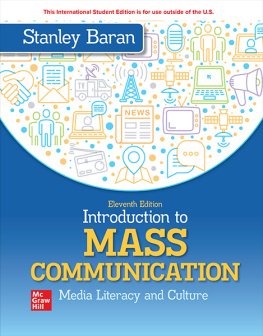Thomas Poffenberger - Reaction to World News Events and the Influence of Mass Media in an Indian Village
Here you can read online Thomas Poffenberger - Reaction to World News Events and the Influence of Mass Media in an Indian Village full text of the book (entire story) in english for free. Download pdf and epub, get meaning, cover and reviews about this ebook. year: 2020, publisher: University of Michigan Center for South and Southeast Asian Studies, genre: Detective and thriller. Description of the work, (preface) as well as reviews are available. Best literature library LitArk.com created for fans of good reading and offers a wide selection of genres:
Romance novel
Science fiction
Adventure
Detective
Science
History
Home and family
Prose
Art
Politics
Computer
Non-fiction
Religion
Business
Children
Humor
Choose a favorite category and find really read worthwhile books. Enjoy immersion in the world of imagination, feel the emotions of the characters or learn something new for yourself, make an fascinating discovery.

- Book:Reaction to World News Events and the Influence of Mass Media in an Indian Village
- Author:
- Publisher:University of Michigan Center for South and Southeast Asian Studies
- Genre:
- Year:2020
- Rating:5 / 5
- Favourites:Add to favourites
- Your mark:
- 100
- 1
- 2
- 3
- 4
- 5
Reaction to World News Events and the Influence of Mass Media in an Indian Village: summary, description and annotation
We offer to read an annotation, description, summary or preface (depends on what the author of the book "Reaction to World News Events and the Influence of Mass Media in an Indian Village" wrote himself). If you haven't found the necessary information about the book — write in the comments, we will try to find it.
Thomas Poffenberger: author's other books
Who wrote Reaction to World News Events and the Influence of Mass Media in an Indian Village? Find out the surname, the name of the author of the book and a list of all author's works by series.
Reaction to World News Events and the Influence of Mass Media in an Indian Village — read online for free the complete book (whole text) full work
Below is the text of the book, divided by pages. System saving the place of the last page read, allows you to conveniently read the book "Reaction to World News Events and the Influence of Mass Media in an Indian Village" online for free, without having to search again every time where you left off. Put a bookmark, and you can go to the page where you finished reading at any time.
Font size:
Interval:
Bookmark:

THE UNIVERSITY OF MICHIGAN
CENTER FOR SOUTH AND SOUTHEAST ASIAN STUDIES
MICHIGAN PAPERS ON SOUTH AND SOUTHEAST ASIA
Editorial Board
John K. Musgrave
George B. Simmons
Thomas R. Trautmann, chm.
Ann Arbor, Michigan
REACTION TO WORLD NEWS EVENTS AND THE INFLUENCE OF MASS MEDIA IN AN INDIAN VILLAGE
by
Thomas Poffenberger and Shirley B. Poffenberger
Michigan Papers on South and Southeast Asia
Number 1
Published in Association With The Center for Population Planning
1971
Open access edition funded by the National Endowment for the Humanities / Andrew W. Mellon Foundation Humanities Open Book Program
Library of Congress Catalog Card Number 73--634904
Copyright 1971
by
Center for South and Southeast Asian Studies
The University of Michigan
Ann Arbor, Michigan 48104
Printed in the United States of America
ISBN 978-0-472-03842-8 (paper)
ISBN 978-0-472-12825-9 (ebook)
ISBN 978-0-472-90225-5 (open access)
The text of this book is licensed under a Creative Commons Attribution-NonCommercial-NoDerivatives 4.0 International License: https://creativecommons.org/licenses/by-nc-nd/4.0/
Acknowledgments
This report deals with one segment of data collected in a village in Gujarat State, India, during a study of social change which was supported by Ford Foundation and Government of India funds. We are grateful to them and to the Department of Child Development of the Faculty of Home Science, M.S. University of Baroda, for the opportunity to conduct this study which was undertaken during the senior authors appointment as Visiting Professor, 1961-65. The findings and interpretations reported here, however, are the sole responsibility of the authors and should not be attributed to policies or points of view of the funding agencies.
Our appreciation goes to Mrs. Amita Verma, Chairman of the Department of Child Development, who encouraged us in our study of village life and cooperated, especially in the development of a research staff; she appointed Miss Vidya Dave of their staff to collect data on school children some of which are reported here, and she facilitated the formation of a group of experienced interviewers whose enthusiastic and sustained years of participation in the collection of data enabled us to acquire a variety of information and a depth of insight about village life which would not have been possible with a less dedicated and able team. This staff included Bihari Pandya, Field Director, and Manubhai Patel who were responsible for the collection of all the male interviews as well as for reports on village institutions and events, and four young women--Rupa Patel, Smita Patel, Taru Parikh, and Katy Mohta--who so persistently interviewed the village women and recorded their observations of the dynamics of family life and prepared reports on village institutions and events related to female activities.
Finally, we wish to express our deepest gratitude to the many villagers whom we came to know as friends--the leaders who accepted our proposal that we study various aspects of village life and who impressed upon the members of their respective groups that they should cooperate with our interviewers--and the many villagers who gave so much of their time answering what must have seemed to be an endless series of questions regarding all aspects of their lives.
The preliminary draft of the report was prepared while the senior author was at the Institute of Advanced Projects, East-West Center, Honolulu, during the year 1968-69; the final report was completed at the Center for Population Planning, University of Michigan, 1970.
Contents
Our major research interest in the village under study was in the area of socialization practices, social change and variables related to fertility behavior. We had not planned a study of the diffusion of news events and villagers reactions to them. However, the Indian Government was considering the use of media for a major mass communication program, to propagate the idea of having small families through the use of family planning methods, and we believed it would be of value to examine any data that might be helpful in getting at least some feeling about what villagers read in the papers and what they heard on the radio, as well as their understanding of the information and their attitudes toward it. We subsequently asked questions about the use of mass media.
In his work on the impact of communication in developing societies, Rogers (1969) remarks on the shortage of studies of the diffusion of and reactions to news. He points out that Greenberg and Parker (1965) in their review of the literature for their report on social communication of the Kennedy assassination in the United States were unable to find a single investigation of news diffusion regarding the assassination anywhere else in the world. He goes on to say, In fact, we have almost no research on the diffusion of news events of any kind outside the United States (one exception is found in Hamuy and others, 1958), in spite of the fact that news diffusion has been one of the most popular topics in mass communication research in the past five years.
Occasionally, those conducting village studies over a period of time have an opportunity to observe a spontaneous event that is worth recording even though it is not a planned part of the research. The following report presents some findings of this kind. We will first report on the results of the survey and then, because of the unquestioned potential importance of mass media as an aid to developing countries in reaching their objectives, we will discuss the implication that we believe our village findings may have.
From 1963 to 1970, the investigators collected data on various aspects of behavior in a village in Gujarat State. The village was located two miles from a major city and was undergoing change from a traditional agricultural economy to one which was becoming more dependent on urban jobs and industrial employment in the numerous factories which were being developed in the rural area adjacent to the city.
The total village population, including hamlets, was 894 males and 796 females at the time of the village census conducted by the research staff in December 1963. The villagers were members of 24 castes and community groups--all that were needed to perform traditional roles and services. Of these, there were four major groups who were sampled and studied throughout the period of the investigation: Patidars, Barias, Bhils and Vankers. The Patidars were high caste farm owners who for generations had maintained effective village political and social control. The Barias were numerically the largest caste but had a middle status level which related to their traditional land tenancy and small land holdings. The Bhils, descendents of tribal people, had originally been brought by Patidar families to serve as farm guards and laborers and were for the most part still employed as farm laborers which caused them to be ranked near the bottom of the social hierarchy. The Vankers, traditionally weavers and for some time forced to serve as collectors of dead cattle, had long been referred to as untouchables although in recent years they had stopped collecting carcasses and had been some of the first villagers to seek factory employment and urban jobs.
The village census data indicated the growing trend for unskilled laborers to seek factory employment; only 17 percent of the productive adult males reported that they were farm laborers while 20 percent reported that they served as unskilled workers in various institutions outside the village especially in the factories which were in commuting distance by bicycle.tinued to be directly engaged in agricultural work, including managerial level farmer-landowners, tenant farmers and farm laborers, yet the traditional cultural value of land ownership was still an important status factor and many families attempted to farm small holdings with the help of women and children and/or hired help while the head of the household or at least one male member of the family served as a factory worker to assure the family at least some basic cash income.
Font size:
Interval:
Bookmark:
Similar books «Reaction to World News Events and the Influence of Mass Media in an Indian Village»
Look at similar books to Reaction to World News Events and the Influence of Mass Media in an Indian Village. We have selected literature similar in name and meaning in the hope of providing readers with more options to find new, interesting, not yet read works.
Discussion, reviews of the book Reaction to World News Events and the Influence of Mass Media in an Indian Village and just readers' own opinions. Leave your comments, write what you think about the work, its meaning or the main characters. Specify what exactly you liked and what you didn't like, and why you think so.





